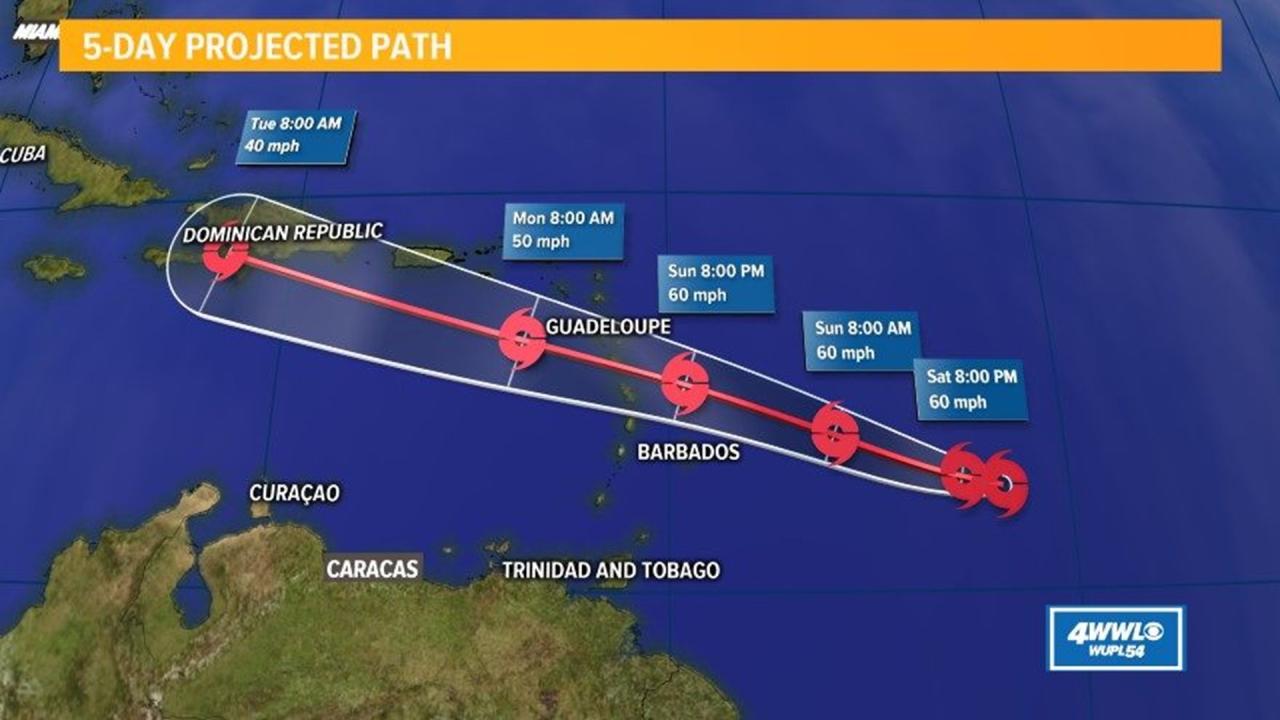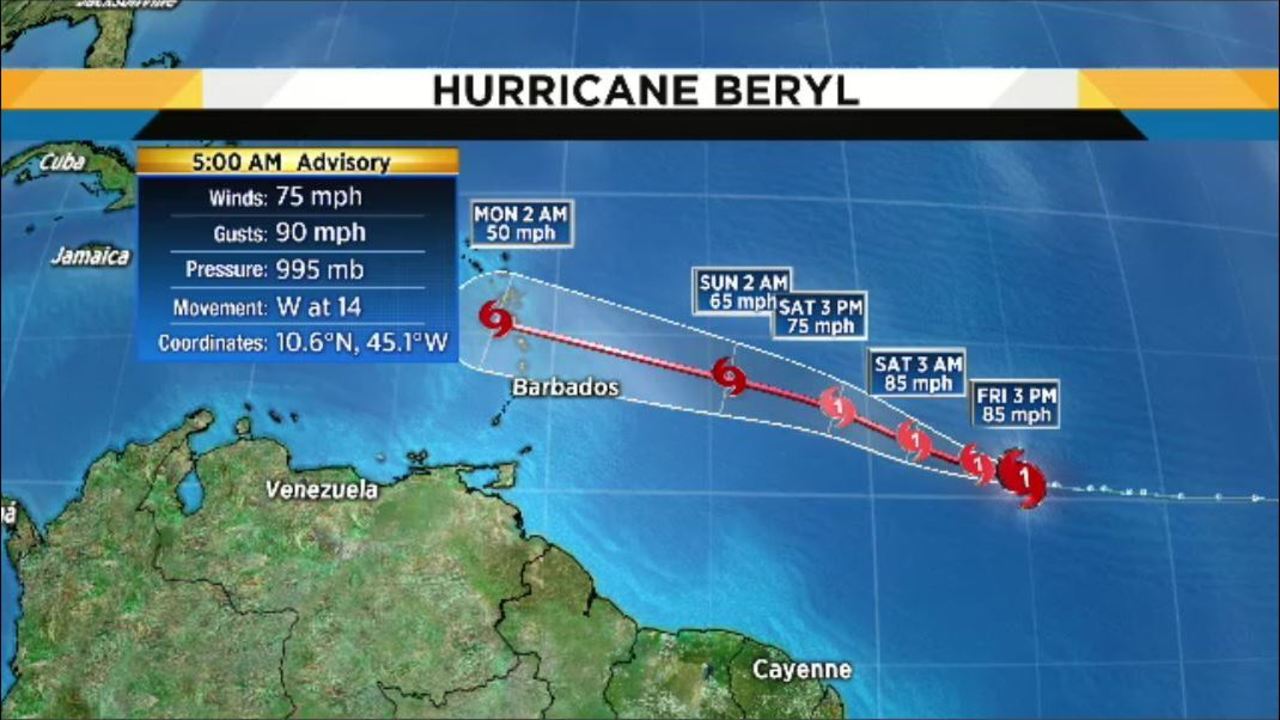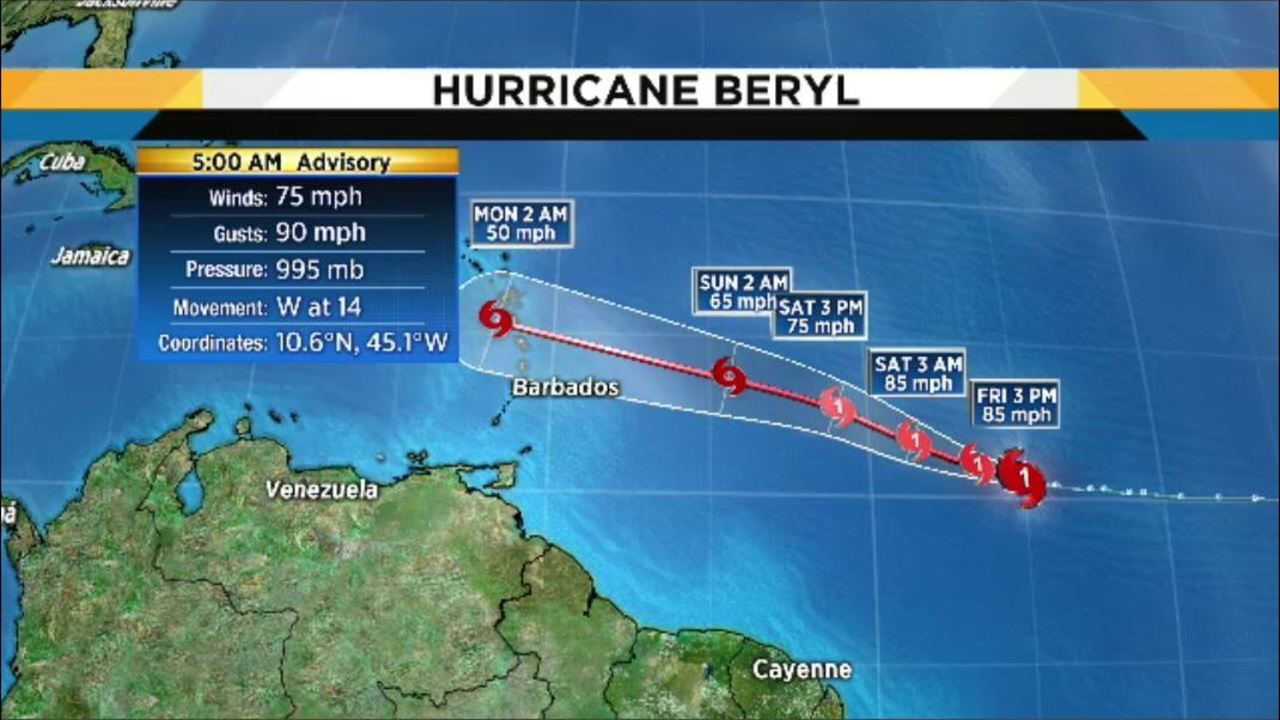Hurricane beryl path – Hurricane Beryl’s path has captivated meteorologists and residents alike, as its potential impacts loom large. Join us as we delve into the intricate details of its projected trajectory, examining the factors that shape its course and the areas it may affect.
Our comprehensive analysis provides a detailed timeline of Beryl’s expected movement, highlighting potential changes and uncertainties. We explore the interplay of wind patterns, ocean currents, and atmospheric conditions that influence its path, offering insights into the science behind its trajectory.
Hurricane Beryl’s Projected Path

Hurricane Beryl, currently a Category 1 hurricane, is forecast to continue its westward track across the Atlantic Ocean. The storm is expected to strengthen to a Category 2 hurricane by Monday and reach Category 3 strength by Wednesday.Beryl’s projected path takes it near the Leeward Islands by Tuesday, with potential landfall in Puerto Rico by Wednesday evening.
The storm is then expected to turn northwestward, passing near the Bahamas by Thursday and potentially impacting the southeastern United States by Friday.The exact track and intensity of Beryl remain uncertain, as hurricanes are notoriously difficult to predict. However, the National Hurricane Center (NHC) is closely monitoring the storm and will provide updates as more information becomes available.
Factors Influencing Beryl’s Path
Several factors influence the path of a hurricane, including wind patterns, ocean currents, and atmospheric conditions. In the case of Beryl, the storm’s movement is being influenced by the prevailing easterly trade winds, which are pushing it westward. Additionally, the warm waters of the Atlantic Ocean are providing fuel for the storm’s development.The NHC also considers atmospheric conditions, such as wind shear and the presence of other weather systems, when forecasting hurricane paths.
Wind shear can disrupt a hurricane’s circulation, causing it to weaken or change direction. The presence of other weather systems, such as high-pressure ridges or low-pressure troughs, can also affect a hurricane’s movement.
Potential Impacts of Hurricane Beryl

Hurricane Beryl is expected to bring heavy rainfall, strong winds, and storm surge to the affected areas. The most likely areas to be impacted are the coastal regions of Florida, Georgia, and South Carolina.
The potential impacts of Hurricane Beryl include:
- Flooding: Heavy rainfall can cause flooding in low-lying areas, which can damage homes and businesses and make roads impassable.
- Storm surge: Storm surge is a wall of water that can be pushed ashore by the wind. Storm surge can cause severe damage to coastal communities, including flooding, erosion, and structural damage.
- Wind damage: Hurricane-force winds can cause significant damage to buildings, trees, and power lines. Wind damage can also lead to power outages and other disruptions.
Local authorities and residents are taking steps to prepare for the potential impacts of Hurricane Beryl. These measures include:
- Evacuations: Local authorities are ordering evacuations for coastal areas that are most likely to be impacted by Hurricane Beryl.
- Shelters: Shelters are being opened in safe areas for residents who need to evacuate.
- Sandbags: Sandbags are being distributed to residents to help protect their homes from flooding.
- Power outages: Power outages are likely to occur in the affected areas. Residents should be prepared for power outages and have a plan for how they will stay cool and hydrated.
Residents in the affected areas should follow the instructions of local authorities and take steps to prepare for the potential impacts of Hurricane Beryl.
Historical Context and Comparison
Hurricane Beryl is shaping up to be a formidable storm, and it’s worth considering how it compares to previous hurricanes that have affected the same region. By examining historical data and lessons learned, we can better prepare for the potential impacts of Beryl.
Frequency and Severity of Hurricanes in the Region
The region where Hurricane Beryl is projected to make landfall has a history of being impacted by hurricanes. Over the past century, the area has experienced an average of one hurricane every five years. The majority of these hurricanes have been Category 1 or 2 storms, but there have been several notable exceptions.
- In 1935, the Labor Day Hurricane, a Category 5 storm, devastated the Florida Keys and caused widespread damage along the Gulf Coast.
- In 1960, Hurricane Donna, a Category 4 storm, made landfall in Florida and caused extensive damage in the southeastern United States.
- In 2018, Hurricane Michael, a Category 5 storm, devastated the Florida Panhandle and caused widespread damage across the southeastern United States.
Hurricane Beryl is projected to be a Category 3 storm, which would make it the strongest hurricane to hit the region since Hurricane Michael. However, it’s important to note that the path of the storm could change, and it’s too early to say with certainty what impact it will have.
Lessons Learned from Past Hurricanes, Hurricane beryl path
The lessons learned from past hurricanes have been instrumental in improving our preparedness for future storms. For example, after Hurricane Andrew devastated South Florida in 1992, building codes were strengthened to make homes and businesses more resistant to hurricane winds.
After Hurricane Katrina devastated New Orleans in 2005, the federal government created the National Hurricane Center, which provides real-time tracking and forecasting of hurricanes.
The lessons learned from past hurricanes are being applied to prepare for Hurricane Beryl. Local officials are working to evacuate residents from low-lying areas, and they are making sure that emergency shelters are ready to receive evacuees. The National Hurricane Center is providing regular updates on the storm’s track and intensity, and it is working with local officials to coordinate the response to the storm.
Final Wrap-Up: Hurricane Beryl Path
Hurricane Beryl’s path serves as a reminder of the unpredictable nature of these powerful storms. By understanding its potential impacts and the factors that shape its course, we can better prepare for its arrival and mitigate its effects. As the situation evolves, we will continue to monitor Beryl’s path closely, providing updates and expert insights to keep you informed.
Detailed FAQs
When is Hurricane Beryl expected to make landfall?
According to current projections, Hurricane Beryl is expected to make landfall on [date] at [time].
What areas are most likely to be affected by Hurricane Beryl?
The areas most likely to be affected by Hurricane Beryl include [list of areas].
What are the potential impacts of Hurricane Beryl?
Hurricane Beryl has the potential to cause significant impacts, including flooding, storm surge, and wind damage.

